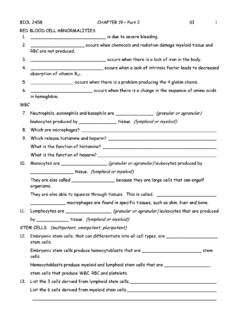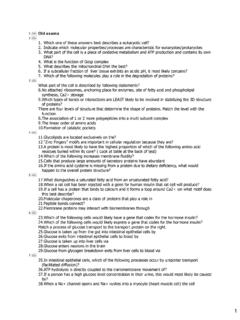Transcription of Biology 1441 Dr Westmoreland Chapter 6: A Tour of the Cell
1 Biology 1441 Dr Westmoreland Chapter 6: A Tour of the Cell I. Microscopy 1. Light microscope: an optical instrument with lenses that refract (bend) visible light to magnify images of specimens. Magnification: is the ratio of an object s image to its real size. (4X, 10X, 100X) Resolution: it is the minimum distance two points can be separated and still be distinguished as two separate points. (200 nm) 2. Electron microscope: focuses an electron beam through a specimen, resulting in resolving power a thousand fold greater than that of a light microscope. Scanning electron microscope: uses an electron beam to scan the surface of a sample to study details of its topography. Transmission electron microscope: a microscope that passes an electron beam through very thin sections; primarily used to study the internal ultrastructure of cells.
2 Q: Which type of microscope would you use to study (a) the changes in shape of a living white blood cell light microscope (b) the details of surface texture of a hair scan electron microscope (c) the detailed structure of an organelle - Transmission electron microscope II. Prokaryotic and Eukaryotic Cells Eukaryotic cells: Cells with true nucleus enclosed in nuclear membrane. Characteristics: complex, larger, with membrane-bound organelles. Prokaryotic cells: Cells without a nucleus. Their DNA is not enclosed in membrane, instead is concentrated in a region called the nucleoid. Characteristics: simple, smaller, no membrane-bound organelles, bacteria The endomembrane system: The collection of membranes inside and around a eukaryotic cell, related either through direct physical contact or by the transfer of membranous vesicles.
3 Includes the nuclear envelope, endoplasmic reticulum, Golgi apparatus, lysosomes, various kinds of vacuoles, and the plasma membrane. Cytoplasm: the entire region between the nucleus and the membrane bounding the cell (plasma membrane). It is made up of a semi-fluid medium where the organelles are suspended within, called the cytosol. Nucleus: the trademark of a eukaryotic cell is its distinctive nucleus, enclosed in the nuclear envelope. Pores in the envelope allow for exchange of macromolecules between the nucleus and the cytoplasm. The nucleus contains the genetic material, DNA, organized along proteins into material called chromatin. As the cell prepares to divide, the stringy, entangled chromatin condenses, becoming thick enough to be discerned as separate structures The nucleolus is the nuclear site where the parts of ribosomes are produced.
4 Ribosomes: carry out protein synthesis in the cytosol (free ribosomes) or attached to the outside of the membranous endoplasmic reticulum (bound ribosomes). Endoplasmic Reticulum (ER) -The ER is a network of membrane-enclosed compartments called cisternae Rough ER: contains bound ribosomes, and is continuous with the nuclear envelope and functions in producing cell membrane and manufacturing proteins for secretion. Membrane and secretory proteins can be transferred to other locations in the cell by the budding of transport vesicles from ER. Smooth ER: lacks ribosomes and synthesizes steroids, metabolizes carbohydrates, stores calcium in muscle cells, and detoxifies poisons in liver cells. Golgi Apparatus: consists of stacks of membranous sacs that synthesize various macromolecules and also modify, store, sort, and export products from the ER The two poles of the golgi stack are referred to as the cis face and the trans face; these act respectively, as the receiving and shipping departments of the golgi apparatus.
5 Lysosomes: a membrane-enclosed sac of hydrolytic enzymes. - Its acidic microenvironment is optimal for the functioning of its enzymes. - The enzymes hydrolyze (break down) proteins, polysaccharides, fats, and nucleic acids. (Phagocytosis) Peroxisome: Membrane-bound organelles that contain specialized teams of enzymes for specific metabolic pathways; all contain peroxide-producing oxidases. Mitochondria: Organelles, which are the sites of cellular respiration, a catabolic oxygen requiring process that uses energy extracted from organic macromolecules to produce ATP. (endosymbiotic theory, membrane is not made by ER, free ribosome and its ribosome) Some of the metabolic reactions of respiration take place in the space enclosed by the inner membrane, the mitochondrial matrix.
6 Cytoskeleton: A network of fibers throughout the cytoplasm that forms a dynamic framework for support and movement. Functions: Give mechanical support to the cell and help maintain its shape. Enable the cell to change shape. Associated with mobility by interacting with specialized proteins called motor molecules ( organelle movement, muscle contraction, and locomotor organelles). The cytoskeleton is constructed from at least three different fibers: microtubules (thickest), microfilaments (thinnest) and intermediate fibers. Microtubules: found in the cytoplasm of all eukaryotic cells. Microtubules are straight hollow fibers, constructed from globular proteins called tubulin, which may be disassembled and the tubulin units recycled to build microtubules elsewhere in the cell.
7 Motor protein: dynein, kinesin. Centrioles: Pair of cylindrical structures in animal cells, composed of nine sets of triplet microtubules arranged in a ring. -are about 150 nm in diameter and are arranged at right angles to each other. Cilia and Flagella: are motile cellular appendages consisting of a 9+2 arrangement of microtubules. They are anchored to the cell by a basal body. Cilia usually occur in large numbers on the surface of the cell. Flagella are the same diameter as cilia but are limited to one or two. Microfilaments (actin filaments): Solid rods build from protein actin. Functions: Microfilaments in muscle cells interact with the protein myosin to cause contraction. Intermediate fibers: Constructed from keratin subunits. More permanent than microtubules or microfilaments.
8 Functions: Framework for the cytoskeleton. FLANT CELL Cell Wall: The cells of plants, prokaryotes, fungi, and some protists are reinforced by cell walls external to the plasma membrane. Plant cell walls are composed of cellulose fibers embedded in other polysaccharides and protein. Extracellular Matrix: Meshwork of macromolecules outside the plasma membrane of animal cells, which functions to provide support and anchorage (adhesion) for the cell. It has also been discovered that ECM helps control the activity of the genes in the nucleus. Intercellular Junctions: Neighboring cells often adhere and interact through special patches of direct physical contact. Plants have plasmodesmata, cytoplasmic channels that pass through adjoining cell walls. -Cell-to cell contact in animals is provided by tight junctions, desmosomes, and gap junctions.
9 Plastids A group of plant and algal membrane-bound organelles that include amyloplasts, chromoplasts, and chloroplasts. Amyloplasts: (Amylo= starch) Colorless plastids that store starch; found in roots and tubers Chromoplasts: (Chromo= color) Plastids containing pigments other than chlorophyll; responsible for the color of fruits, flowers and autumn leaves. Chloroplasts: (Chloro= green) Chlorophyll-containing plastids which are sites of photosynthesis. Chloroplasts are enclosed by two membranes surrounding the fluid inside called the stroma. Embedded in the stroma are membranous sacs called thylakoids. These flattened sacs are stacked in some regions, forming grana. Vacuoles: Organelle with is a membrane-enclosed sac that is larger than a vesicle.
10 Types and functions: Food vacuole: Vacuole formed by phagocytosis which is the site of intracellular digestion in some protists and macrophages. Contractile vacuole: Vacuole found in some fresh-water protozoa, that pumps excess water from the cell. Central vacuole: Large vacuole found in most mature plant cells. Is enclosed by a membrane called the tonoplast which is part of the endomembrane system. Develops by the coalescence of smaller vacuoles derived from the ER and Golgi apparatus. Many functions: storage, waste disposal, cell elongation, and protection. IMPORTANT: * Be able to draw and label an animal cell containing: plasma membrane, cytoplasm, nucleus with nucleolus, ER, mitochondria, ribosomes, and golgi apparatus * Be able to draw and label a plant cell containing: Cell wall, plasma membrane, nucleus with nucleolus, central vacuole, mitochondria, chloroplasts, ER, and golgi apparatus.








